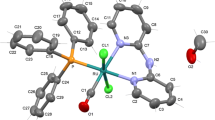Conclusions
-
1.
The increased electron-donating reactivity of the 0 atom in CpRh(η4-C7H7-2-COR) complexes, where Cp=η5-C5H5, η5-C5H4Me, and η5-C5Me5 and R=H, Me, has been characterized by IR spectroscopic investigation and by the formation of hydrogen bonding with 4-fluorophenol.
-
2.
The basicity of the 0 atom in the formyl group in organometallic aldehydes increases in the series: (CO)3MnC5H4CHO < C5H5FeC5H4CHO < C5H5RhC7H7-2-CHO; in (Cp)Rh(η4-C7H7-2-CHO) norbornadiene π-complexes the basicity of the formyl 0 atom increases as the donating ability of the Cp ligand increases, in the series Cp=C5H5 < C5Me < C5Me5.
-
3.
The CpRhC7H7-2 group acts as a substituent with a strongly positive inductive effect as well as with a resonance effect of the same sign.
Similar content being viewed by others
Literature cited
A. A. Koridze, I. T. Chizevsky, P. V. Petrovsky, et al., J. Organomet. Chem.,206, 373 (1981).
I. T. Chizevskii, N. V. Rastova, N. E. Kolobova, L. E. Vinogradova, and L. A. Leites, Izv. Akad. Nauk SSSR, Ser. Khim., 1382 (1985).
I. T. Chizevskii, A. A. Koridze, and N. E. Kolobova, Izv. Akad. Nauk SSSR, Ser. Khim., 935 (1984).
I. T. Chizevskii (Chizhevsky), N. V. Rastova, N. E. Kolobova, V. F. Sizoi, and Yu. S. Nekrasov, XI Intern. Conf. of Organometallic Chemistry, Atlanta (1983), p. 124.
C. P. Lillya and R. A. Sarantjan, J. Organomet. Chem.,32, 371 (1971).
M. Brookhart and D. L. Harris, J. Organomet. Chem.,42, 441 (1972).
P. Powell, J. Organomet. Chem.,206, 229 (1981).
A. V. Iogansen, S. E. Kiselev, B. V. Rassadin, and A. A. Samoilenko, Zh. Struk. Khim.,17, 629 (1976).
I. A. Zakharova, Ya. V. Salyn, I. A. Garbouzova, V. T. Aleksanyan, and M. A. Prianichnikova, J. Organomet. Chem.,102, 227 (1975).
I. T. Chizevskii, A. A. Koridze, P. V. Petrovskii, and N. E. Kolobova, Izv. Akad. Nauk SSSR, Ser. Khim., 1124 (1981).
B. L. Booth, R. N. Haszeldine, and M. Hill, J. Chem. Soc. A, 1299 (1969).
R. Gelin and A. Debard, Bull. Soc. Chim. Fr., 144 (1966).
Author information
Authors and Affiliations
Additional information
Translated from Izvestiya Akademii Nauk SSSR, Seriya Khimicheskaya, No. 4, pp. 890–893, April, 1987.
Rights and permissions
About this article
Cite this article
Vinogradova, L.E., Chizevskii, I.T., Rastova, N.V. et al. 2-Acylnorbornadiene-rhodium π-complexes: Comparison of electron-donating properties of carbonyl group oxygen atoms. Russ Chem Bull 36, 817–820 (1987). https://doi.org/10.1007/BF00962329
Received:
Issue Date:
DOI: https://doi.org/10.1007/BF00962329




